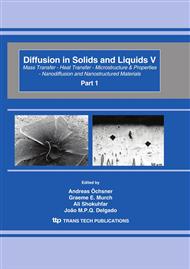p.1432
p.1439
p.1445
p.1451
p.1461
p.1469
p.1475
p.1481
p.1487
Bi-Velocity Method and Linear Nonreversible Thermodynamics, Interdiffusion in R2
Abstract:
Kirkendall and Darken findings of the drift velocity since 1948 have stimulated progress in transport phenomenological models. The convection velocity (the Darken drift in solids), , and velocity of diffusion, , require definition and the method how the diffusion displacement is defined, computed and measured. The equation of volume continuity allowed the extension of the Darken method and avoids the rigid assumption of the constant molar concentration. In this work, we use the bi-velocity approach, i.e., the generalized Darken method, to model interdiffusion in two-dimensional diffusion multiple. We show the convergence of one- and two-dimensional models in the case of the process at the constant volume and perfect agreement between R1 and R2 simulations. We impose modifications in the foundations of mechanics of solids namely, the Navier-Lamé-Fourier equations. We show that the method can be used in the mechano-chemistry of solids and is self-consistent with linear irreversible thermodynamics.
Info:
Periodical:
Pages:
1461-1468
Citation:
Online since:
April 2010
Authors:
Price:
Сopyright:
© 2010 Trans Tech Publications Ltd. All Rights Reserved
Share:
Citation:


